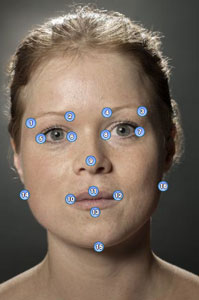Appearance is extremely significant in determining how we assess a person’s personality. However, a new study based on test subjects from DTU suggests that people often form the wrong conclusions.
Is it possible to form an impression of people’s personalities simply by examining their facial features? This is the question that Karin Wolffhechel from DTU Systems Biology has been examining as a part of her PhD programme—and the short answer is ‘no’.
Nevertheless, our faces do reflect a few specific personality traits. For example, men with broad jaws will often be viewed as dominant, as they do indeed have a slight tendency to be. Similarly, it is likely that women whom other people assess as being adventurous and emotionally stable will also have aspiration as a clear feature of their personality.
Karin has found no evidence of unambiguous correlation, but that does not stop people drawing their own conclusions, of course. Because it is common knowledge that we instinctively rely on facial features when forming our initial impression of a person. And that is precisely why we often make mistakes and tend to generalize when assessing people’s personalities on the basis of their features.
“We discovered that people usually apply three general factors when evaluating a face: credibility, dominance, and attractiveness. People largely agreed on the extent to which a person inspired confidence and appeared responsible and intelligent. We also noted that if a person was considered attractive, then he or she would typically be classed as more adventurous, extrovert, healthy and emotionally stable. Finally, people were in close agreement regarding how dominant a given person would be,” says Karin Wolffhechel. She continues:
“So it is clear that people are heavily influenced by the facial features of others. If, for example, you have a ‘neutral’ face that has a natural tendency to appear smiling, people will typically assume that you are a friendly person—even though this may be a false assumption.”
Test the model
The study has now produced a model that can predict which initial impressions people generate. You can test the model online at face.cbs.dtu.dk.
244 test subjects
As a part of the experiment, 244 staff and students at DTU had pictures taken of their ‘neutral’ faces. The same set-up and background were used for all the pictures. Reference points were then applied to the pictures to allow the calculation of coordinates to describe the facial features.
The test subjects were required to take a personality test designed to highlight five general personality traits— sociability, responsibility, extroversion, emotional stability, intellectual openness—and 17 subordinated features.
Finally, the test subjects were asked to evaluate pictures of 20 other participants, scoring twelve different personality traits and facial features on a scale of 1 to 9.
 |
|
See how others assess you
Upload a photo which is a good likeness of yourself—with a neutral facial expression—to face.cbs.dtu.dk to receive an evaluation of the first-hand impression you are likely to make on other people. The page will annotate (i.e. mark) the image, and the distance between the reference points will reveal how you are likely to be evaluated with regard to 12 personality traits and facial features.
Upload a photo which is a good likeness of yourself—with a neutral facial expression—to face.cbs.dtu.dk to receive an evaluation of the first-hand impression you are likely to make on other people. The page will annotate (i.e. mark) the image, and the distance between the reference points will reveal how you are likely to be evaluated with regard to 12 personality traits and facial features.
We have used a picture of Karin Wolffhechel here. Using the reference points on the face, it is possible to measure the facial features required to complete the analysis. These features include aspects such as the width of the jaw and the mouth, and the position of the eyes in the face.
|
So how did Karin herself score?

Article in DTUavisen no. 10, December 2014.